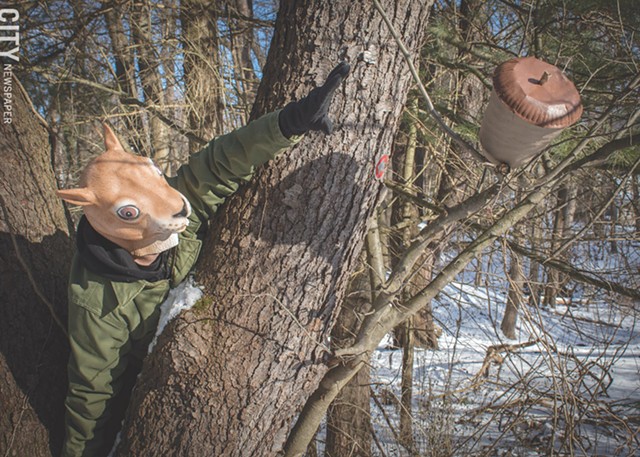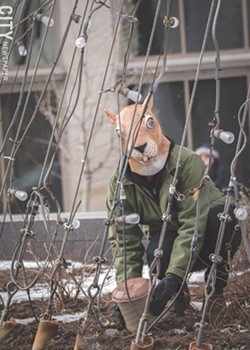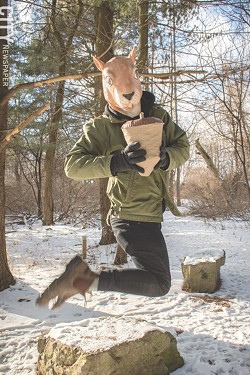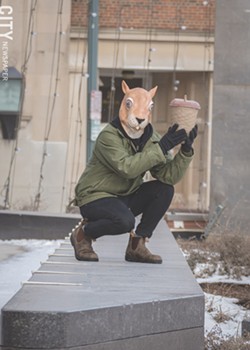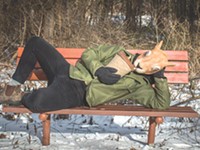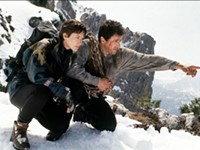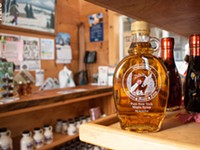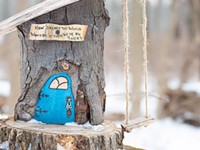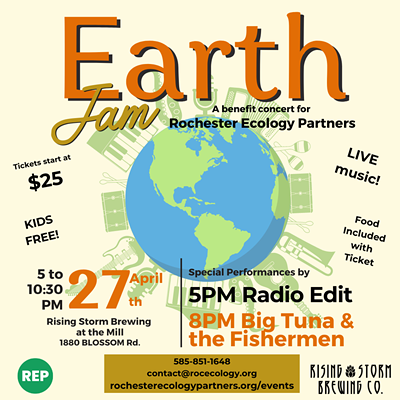[
{
"name": "500x250 Ad",
"insertPoint": "5",
"component": "15667920",
"parentWrapperClass": "",
"requiredCountToDisplay": "1"
}
]
We're deep in the cold-weather doldrums. And our quick, begrudging trips from home to work or the grocery store and back home again may leave us with a vague impression of a winter wasteland. At a glance, the landscape may seem hushed and abandoned compared to nature's activity in the other seasons. Many birds migrate south, and many mammals may be hunkered down in hibernation mode.
But there are still signs of wildlife around, if we know where to look and how to detect them, says Douglas Bassett, a naturalist at Letchworth State Park. Bassett, who's been with Letchworth since 1973, leads year-round interpretive hikes in the park. In a recent interview, Bassett talked about the animals, plants, and indications of nature's interconnected stories that can be read in the terrain. The following is an edited version of that conversation.
There are loads of interpretive nature walks and themed wildlife events for all ages taking place throughout the rest of the winter at area nature centers, wildlife refuges, and parks. Check out our calendar at rochestercitynewspaper.com for listings of upcoming events.
CITY: Aside from the basics like squirrels, chickadees, and cardinals, what are some regional animals that stick around in the winter?
Douglas Bassett: Well, we have over 15,000 organisms, so to summarize, it's whatever you're looking at that's exciting, and that changes every day. The winter snow brings you an opportunity, though, to have a nose like a fox. You can see what's been there, you can see fox tracks, you can see raccoon tracks, possum tracks, and without the snow you wouldn't know when they were there. With the snow, not only do you know who was there, you can tell by the age of the snow and what the conditions have been, how long ago it was there, and which direction it was going, where it stopped, and what it did.
Winter walks give a whole opportunity to look into the life of animals, from shrews and mice all the way up to deer.
What do you think are the best scenarios and best practices to spot active wildlife?
Actual sightings of animals is always rare, and if you have more than one person, the rarer it becomes. So in groups, we hardly ever see animals up close. It might be far, we might see a coyote crossing a river, or a deer on a far bank, but we don't usually see animals up close because of the sheer fact of numbers, movement, and noise. So if you're by yourself, and you're walking slowly, and stop often — if you're stopped more than you are walking — you increase your chances of seeing something before it sees or smells you.
Can you elaborate a bit on indicators in the snow, such as tracks, and the age of the snow?
If we've had a recent dusting of snow, a track made in the morning would have a little dusting of snow in it. If there was no dusting of snow in the tracks, it's pretty darn fresh, maybe only minutes or hours ago. If there's been a melting condition, the tracks become melted and smooth. Of course, if you got a snow that happened five days after the track, the track has disappeared.
So the timing of the snow, the depth of the snow, the conditions, the warmth all help in your process of knowing how long ago that animal was there. And when you're looking at the track, you can tell the heel and the toe, so you can tell the direction of the track, and you can also tell by the gait whether the animal was walking, hopping, running, whether it was leaping. There's a whole bunch of information, and none of it is there the rest of the year.
What are some particular areas of interest for you? Do you have a specialty?
I'm a generalist. I know a little bit about a lot of things, expert of nothing. But the more you know, the more you know you don't know. That's how that story goes. I am always interested in the interrelationship of things: How one thing depends on another, how something feeds on this or that. The chain of events is always the intriguing thing for me.
What sort of chains of events have you detected?
We saw some bear tracks on one of our walks. You don't see them that often. We didn't have time then, so I came back to explore the tracks. I walked backward on the tracks, followed them for five miles, and it went all kinds of places I didn't know a bear would go. It crossed logs, it crossed creeks, it did turns and twists I wouldn't have necessarily chosen if I was walking through the woods. And in one spot it was going through a tangle of honeysuckle. I wouldn't have bothered to go through a tangle, but it did. I would have gone around it. Not only did it go through it, at one point it rolled over on top of a honeysuckle and broke it, and pieces were there sticking out. I think it had an itch, and it was just rolling around on top of the honeysuckle.
What about plants, and the challenge of identifying trees just by their bark?
The beauty of the bark is that it's there year-round, and every single tree can be identified by its bark. But the challenge of that is the bark changes from when it's a seedling to when it's a sapling, to when it's 5, 10, 20, 50, 100, 200 years old. It goes through many changes. The bark of a tree is also different on the upside than from the downhill side: On the uphill side it stretches, on the downhill side it compresses, so on the same tree you could have more variation at one level than you could have between trees. So you've got to pull all of that together and notice the differences, how the bark is slightly different. The colors are all basically the same. Some are darker, some are lighter, some have hues toward red, yellow, or blue.
Any other comments about particular plants?
The other thing we can often notice about the leaves on the plants is there's a lot of other organisms on them, and they can sometimes create galls, or swelling structures you wouldn't expect to see. [Galls are abnormal growths that occur on different parts of plants, caused by irritation to the plant cells from feeding or egg-laying by insects]. Plant galls are often an interesting feature in the winter. You can see the willow pine cone gall, for example, if you're in a willow habitat. It looks like a pinecone, but what's it doing on a willow? It's the way the plant responds to the little midge that creates the gall. And then there's other things that might utilize that gall.
One of the most famous gall interactions is the goldenrod ball gall. It's caused by little flies related to a fruit fly. But there's a beetle that will eat things that are in that gall. It preys upon whatever is there. But it may not be the fly's larvae. It may be a wasp. There's a wasp whose only food in the world is that fly. And if that wasn't complicated enough, there's a wasp that only eats the wasp that eats the fly. And the beetle doesn't care, it eats whatever's in there.
And then of course a downy woodpecker could tap into that gall and break it open, and get whatever is in there. There's a whole microcosm of interrelationships.
What are some of the most exciting winter life you've encountered in your years of studying nature up close?
One time we followed an otter track, and you could see where instead of just going forward, it would take advantage of the topography. Where there was a little bit of a slope, it would slide. You could see the belly slide where it might slide 5, 10 feet, and at one point it slid down an entire slope that must have been 30 or 40 yards. You could say it was having fun, you could say it was economizing, but when you got to a slope and saw that it had gone back up the slope and then come down again, you really had a hard time thinking it was doing anything other than having fun.
What advice would you give to amateur naturalists for their best chances of witnessing wildlife, or keeping an eye out for indications of wildlife?
Best is to go slow, and bring a hand lens. Look at things closely, observe, and don't worry necessarily about putting names on things. There's things that I've seen again and again and I still don't know what they are. But by observing them, taking the time to use all of your senses, you get to know some of the things that are around us a little bit better.
What is a benefit of humans paying attention to the life that's around them in the winter, as opposed to just holing up and hibernating ourselves?
It's rooted to the human condition. We isolate ourselves from the world. We put ourselves in boxes: We call it business, we call it a car, we call it a house, and we separate ourselves from everything else the world has to offer. Any by going out and taking this in, you get a connection of life, a purpose, of interconnectedness, that yes, your little actions may or may not have an immediate result, but everything does have an interconnectedness to everything else. And there is something, whether you can put your finger or words on it.
In This Guide...
Latest in Winter Guide
More by Rebecca Rafferty
-

Beyond folklore
Apr 4, 2024 -

Partnership perks: Public Provisions @ Flour City Bread
Feb 24, 2024 -

Raison d’Art
Feb 19, 2024 - More »
